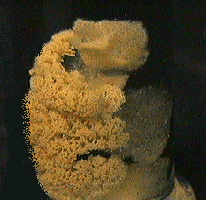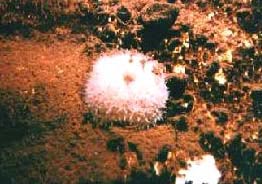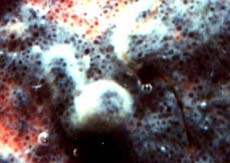
|
The sponges are primitive metazoans, at present including more than 10.000 described species, most of them marine, skialophilous and bathyphilous, only a few living in continental fresh waters. They are exceptionally found also in ground waters, where generally are to be considered stygophilic or stygoxen colonizers.
In most cases (Demosponges) groundwater sponges have been reported from coastal caves, where they live in brackish or oligohaline waters, not far from the cave entrance, sometimes not in complete darkness and showing close affinities and resemblance with marine forms; some sponges (Spongillides) are known to inhabit also continental ground waters, only a few showing true stygobitic characteristics.
In submarine caves sponges are adapted to such ecological conditions as those of deep-sea environments, viz. absence of photosynthetic production, low flux of organic matter, light absence and low imput of energy. A
As regard subterranean sponges from Italy, the following species were known:Petrosia pulitzeri Pansini 1996, from marine cave waters in the Gulf of Neaples, along the Ionian coast of Sicily and the Adriatic sea, Myrmekioderma spelaea (Pulitzer-Finali 1983), from cavities under ledges at the Zinzulusa Bay and from other marine caves (Tremiti, Massalubrense) and Petrobiona incrustans Sarà 1963, from the coastal cave "Grotta del Presepe" at S.M. di Leuca, but the last species could be considered stygophilic colonizer of ground waters since it lives not far from the cave opening, not in complete darkness, in zones of relatively intense water movements.
Other records of sponges from marine cave waters of south Italy (Apulia) are referred to numerous (25!) species found in the "Grotta della Regina" cave, at Torre a Mare (Bari) and to fifteen demosponges recorded by Pulitzer-Finali (1983) from the Zinzulusa Bay, but all of them are stigophilic or stygoxen colonizers of coastal ground waters.
R Recently, in the course of the research program "Zinzulusa: Speleosub '96", promoted by the Culture Aldermanship of the Castro Commune and the Alderman Nini Ciccarese, with the collaboration of the "Gruppo Speleologico Salentino - P. de Lorentiis" and the "Gruppo Speleologico Neretino", a stygobitic new species of sponge belonging to the order Axinellida (Demospongiae), Higginsia ciccaresei sp.n. (left photo),has been collected, by diving, from
a new submerged way in the Zinzulusa cave (South Italy), about 250 m far from the cave entrance, at a depth of about 12 m, in complete darkness and in brackish waters (salinity = 20 p.p.t.), with temperature ranging from 18.5 to 18.9°C. The specimens are whitish, subcircular in shape, with a diameter of 1.5 - 2 cm, as well as they show a large oscule and short conules around the body. Other encrusting sponges (right photo), still in course of description, have been collected from the above locality, in association with water mites and polichaete anellids.
In the same locality other characteristic true stygobitic taxa, such as the remarkable decapod Typhlocaris salentina, the mysids Spelaeomysis bottazzii and Stygiomysis hydruntina and the amphipod Salentinella gracillima, the latter two previously unrecorded from the Zinzulusa cave, have been identified.
However, as some authors already suggested, more surprises could be revealed by the course of the continuing exploration of this cave!
Recently a (stygophilic ?) sponge was collected by A. Costantini (Gruppo Speleologico Neretino) from the cave "Tre Furneddhe", south of S. Caterina di Nardò (Lecce), at 15 m from the cave entrance, depth 5 m.
 REFERENCES REFERENCES
A selected World bibliography on subterranean sponges can be found in: R.W.M. Van Soest & M. Velikonja (1984).Porifera. Stygofauna Mundi: 30-32; Vacelet J. (1994). Porifera. Encyclopaedia Biospeologica. Societè de Biospéologie, Moulis, Bucarest: 35-38; Vacelet J., N. Boury-Esnault & J.-G. Harmelin. 1994. Hexactinellid cave, a unique deep-sea habitat in the scuba zone. Deep-sea Research, 41 (7): 965-973; Sket B. & M. Velikonja. 1984. Preliminary report on findings of freshwater sponges (Porifera, Spongillidae) in caves in Yugoslavia. Deveti jugosl. spel. kongr:553-557; Sket B. & M. Velikonja. 1986. Troglobitic freshwater sponges (Porifera, Spongillidae) found in Yugoslavia. Stygologia, 2 (3):253-266. T M. Pansini & G.L. Pesce (1998). Higginsia ciccaresei sp. nov. (Porifera: Demospongiae) from a marine cave on the Apulian coast (Mediterranean Sea). J. Mar. Biol. Ass. U.K., 78: 1083-1091.
La Storia del Mondo in una Spugna |





 Report comments and suggestions to
Report comments and suggestions to